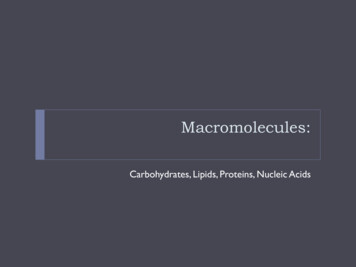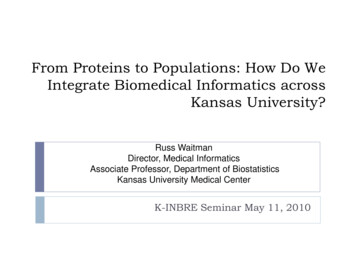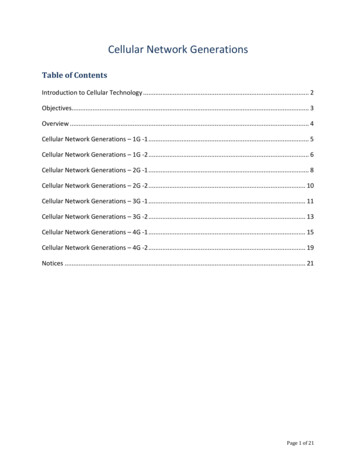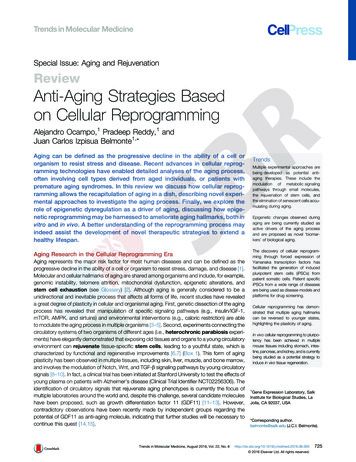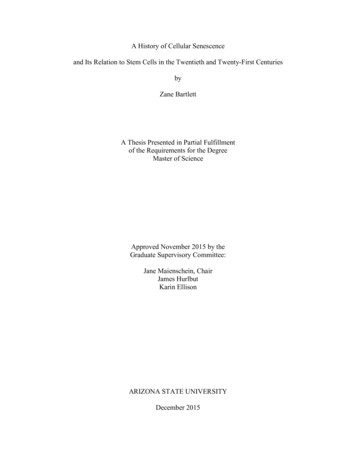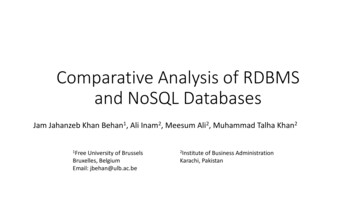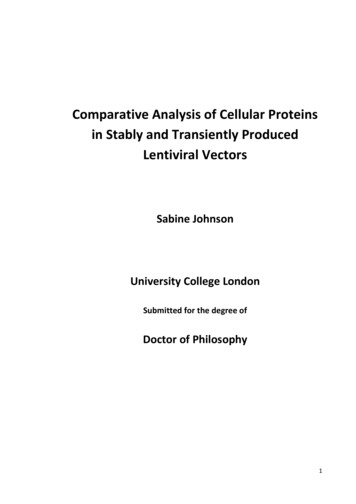
Transcription
Comparative Analysis of Cellular Proteinsin Stably and Transiently ProducedLentiviral VectorsSabine JohnsonUniversity College LondonSubmitted for the degree ofDoctor of Philosophy1
I, Sabine Johnson confirm that the work presented in this thesis is my own. Where informationhas been derived from other sources, I confirm that this has been indicated in the thesis.2
AbstractLentiviral vectors (LVs) are successfully used in clinical trials showing long term therapeuticbenefits. Studying the role of cellular proteins during replication of lentivirus HIV-1 helped tounderstand virus assembly and budding. Knowing what cellular proteins interact with viralproteins and identifying interactions that promote formation of functional particles can bevaluable for improving LV production in Gene Therapy.The cellular protein composition of LVs produced by two different methods was compared, thetransient transfection system producing vectors pseudotyped with the VSV-G envelope and astable producer cell system producing vectors pseudotyped with the non-toxic retroviralenvelope, RDpro.Lentiviral vectors were purified using size exclusion chromatography (SEC). The number ofpurified LVs produced by transient transfection was six fold higher compared to stablyproduced particles. For linear ion trap-orbitrap tandem mass spectrometry (LTQ-MS/MS) acomparable amount of SEC purified LVs was analysed, detecting a smaller number of cellularprotein species in stably compared to transiently produced vector samples.The greater numbers of host proteins in purified transiently produced samples may due to thepresence of co-purified VSV-G vesicles. On the other hand, a large number of proteins weidentified had also been detected in studies of wild type viruses and HIV-1 derived vectorsindicating a role in vector formation, such as viral protein transport to the assembly site inproducer cells. The potential role in LV particle production of selected identified proteins wasassessed. Whilst some proteins that have been detected in studies on wild type HIV-1 werefound in all our samples, such as ALIX, AHNAK was unique to stably produced, RDpropseudotyped vector samples, and thus selected for further investigation. In summary, knockdown of ALIX, AHNAK and TSG101 host cell proteins in vector producer cells did not result in asignificant difference in vector production.3
Table of ContentsAbstract . 3Acknowledgements. 9Tables and Figures . 10Tables . 10Figures . 12Abbreviations . 151.Introduction . 201.1.General Introduction. 201.2.Biology of Lentiviruses . 211.2.1.Classification of Retroviruses . 211.2.2.HIV-1 Genome and Life Cycle . 211.2.3.HIV-1 Virus Structure . 231.2.4.HIV-1 Entry . 231.2.5.HIV-1 Reverse Transcription . 241.2.6.HIV-1 Nuclear Entry and Integration . 271.2.7.HIV-1 Transcription . 281.2.8.HIV-1 RNA processing, Nuclear Export and Translation . 291.2.9.HIV-1 Assembly . 301.2.10.HIV-1 Budding . 331.2.11.HIV-1 Maturation . 334
1.2.12.HIV-1 Cell-to-Cell Transmission . 341.2.13.Association of Host cell Proteins with Released HIV-1 Virions . 341.2.14.Association of Host cell Proteins with Enveloped Viruses . 361.2.15.Brief Molecular Biology of Vesicular Stomatitis Virus and RD114 Virus . 371.3.1.3.1.Gammaretroviral Genome and Particle Structure . 391.3.2.Development of Gammaretroviral Vectors . 401.3.3.Gammaretroviral Vectors in Gene Therapy Trials . 421.4.2.Gammaretroviral Vectors . 39Lentiviral Vectors . 481.4.1.Advantages of Lentiviral over Gammaretroviral Vectors . 481.4.2.Lentiviral Vectors in Gene Therapy Trials . 491.4.3.Development of Lentiviral Vectors . 531.4.4.Non-HIV-1 Lentiviral Vectors . 581.4.5.Viral Vector Pseudotyping. 591.5.Viral Vector Production: Transient Transfection . 611.6.Stable Vector Production Systems . 621.7.Aim of Thesis . 67Materials and Methods . 682.1.Cell Culture . 682.2.Amplification and Purification of DNA plasmids . 682.2.1.Preparation of Chemically Competent Bacteria Cells . 682.2.2.Transformation of Competent Cells with Plasmid DNA . 692.2.3.DNA Plasmid Preparation. 705
2.2.4.2.3.DNA Plasmids . 70Lentiviral Vector Preparation and Characterisation . 712.3.1.Vector Production . 712.3.2.Lentiviral Vector Purification using Size Exclusion Chromatography. 722.3.3.Purified Lentiviral Vector Sample Preparation for Mass Spectrometry. 732.4.Lentiviral Vector Characterisation . 752.4.1.Vector Titration by Fluorescence Activated Cell Sorting (FACS) . 752.4.2.Vector Titration by p24 ELISA (Chapter 3) . 772.4.3.Vector Titration by p24 ELISA (Chapter 5) . 782.4.4.Vector Genome Titration by Quantitative Reverse Transcription PolymeraseChain Reaction (Q-RT-PCR) . 782.4.5.2.5.Lentiviral Vector Protein Detection using Silver Staining and Western Blotting 82Knock-Down of Cellular Protein Expression. 842.5.1.GIPZ shRNA-Lentiviral Vector Preparation. 842.5.2.Transduction of LV Producer Cells with GIPZ-LVs to Deliver shRNA . 852.5.3.Production of LVs by STAR-GIPZ and 293T-GIPZ Cells . 852.5.4.Preparation of Cell Lysates. 862.5.5.Protein Concentration Measurement using BCA assay . 862.5.6.Functional Category and Canonical Pathway Analysis of LC-MS/MS Data . 872.6.Materials and Methods - Appendix . 883. Lentiviral Vector Production and Purification by Size Exclusion Chromatography . 963.1.Introduction . 963.2.Aim . 1016
3.3.Results . 1023.3.1Production of LVs –Differences in Titer of Transiently and Stably ProducedVectors . 1033.3.2.Size Exclusion Chromatography of Vectors – Elution of LVs in Void. 1053.3.3.SDS-PAGE Silver Staining of Purified Vector Samples . 1103.3.4.Recovery of Infectious Particles in Void Peak . 1113.3.5.240 fold Concentration of Stably Produced Samples Results in ComparableAmount of Viral Proteins to 40 fold Concentrated Transiently Produced Samples. 1123.3.6.Desalting and Lyophilisation of SEC Void Fractions in Preparation for MS study. 1193.3.7.3.4.Summary of Vector Sample Preparation for LC-MS/MS . 121Discussion. 1244. Protein Composition of Purified Vector Samples Analysed by Tandem Mass Spectrometry. 1314.1.Introduction . 1314.2.Aim . 1334.3.Results . 1344.3.1.Optimisation of Vector Sample Preparation for MS analysis . 1344.3.2.LC-MS/MS Settings for Data Acquisition and Analysis . 1364.3.3.LC-MS/MS Data Analysis . 1374.4.5.Discussion. 161Effects of Cellular Protein Expression on Producer Cells in Lentiviral Vector Production 1765.1.Introduction . 1767
5.2.Aim . 1825.3.Results . 1825.3.1.Screen for Efficient Knock-Down of shRNAs Targeting MS Identified HostProteins . 1835.3.2.Analysis of GIPZ-LV producer cells . 1845.3.3.Analysis of Vectors Produced by GIPZ-Producer Cells . 1955.4.6.Discussion. 211General Discussion . 2216.1. Discussion of Vector Purification . 2226.2.Discussion of MS results and Identified Protein Functions. 2246.3.Discussion of Protein Knock-Down . 2276.4.Concluding Remarks. 2297.Future Work . 2308.References . 2328
AcknowledgementsI would like to thank my supervisors Yuan Zhao and Yasu Takeuchi for giving me theopportunity to do this research project under their guidance. Their constant support andfeedback throughout the last three and a half years have been vital for me to complete thiswork.I also would like to thank everyone who was involved in this project at the National Institutefor Biological Standards and Control, including Jun Wheeler for conducting the massspectrometry as well as Robin Thorpe, Carl Dolman and Natalie Werling for their advice. MaryCollins and the members of her research group as well as members of the Wohl Virion Centreat the University College London have also contributed to this work by giving valuable advice inlab meetings and training in techniques, including Sean Knight, Mehdi Baratchian, KhaledSanber and Kanayo Doi.I express special gratitude to my parents for supporting me throughout my education. Finally, Iwant to thank my husband, Daniel for always being there.9
Tables and FiguresTablesTable 1: Vector Samples for LC-MS/MS Analysis . 88Table 2: DNA plasmids used in Transient Transfections . 89Table 3: Primer for Q-PCR of Vector RNA Genome. . 91Table 4: Calculation of pHV Plasmid DNA Standard Molecular Weight Used in Q-PCR of VectorRNA Genome. 92Table 5: PCR reaction Set-Up. . 92Table 6: Q-PCR program. 93Table 7: Composition of acrylamide gels used in Western blotting. . 93Table 8: Composition of Buffers Used in Western Blotting. . 94Table 9: pGIPZ-shRNA Plasmids. . 94Table 10: Viral Vector Batches used in Sample Preparation for LC-MS/MS Analysis . 104Table 11: Bradford Assay of Purified Vector Sample Set 2 for LC-MS/MS. 120Table 12: Overview of Vector Samples Prepared for Mass Spectrometry (MS) analysis . 123Table 13: Coverage of Viral Protein Sequences by LC-MS/MS in Purified Vectors. 138Table 14: LC-MS/MS Identified Proteins in all Vector Samples (listed in the order of theirdetection in MS set 1 of vector samples, then grouped). 143Table 15: Coverage of Selected Host Protein Sequences (in %) detected by LC-MS/MS inPurified Vectors. 149Table 16 : Top Molecular and Cellular Functions of LC-MS/MS Identified Proteins. 152Table 17: LC-MS/MS Identified Proteins Unique to Samples Containing VSV-G . 156Table 18: Functions of Proteins Common to Transiently and Stably Produced LV Samples . 159Table 19: LC-MS/MS Identified Proteins Common to Enveloped Viruses and Vectors . 165Table 1: Vector Samples for LC-MS/MS Analysis . 8310
Table 2: DNA Plasmids Used in Transient Transfections . 84Table 3: Primer for Q-PCR of Vector RNA Genome. . 86Table 4: Calculation of pHV Plasmid DNA Standard Molecular Weight Used in Q-PCR of VectorRNA Genome. 86Table 5: PCR Reaction Set-Up. . 87Table 6: Q-PCR Program . 87Table 7: Composition of Acrylamide Gels Used in Western Blotting. 88Table 8: Composition of Buffers Used in Western Blotting. . 88Table 9: pGIPZ-shRNA Plasmids. . 89Table 10: Viral Vector Batches Used in Sample Preparation for LC-MS/MS Analysis. 98Table 11: Bradford Assay of Purified Vector Sample Set 2 for LC-MS/MS. 114Table 12: Overview of Vector Samples Prepared for Mass Spectrometry (MS) Analysis . 117Table 13: Coverage of Viral Protein Sequences by LC-MS/MS in Purified Vectors. 131Table 14: LC-MS/MS Identified Proteins in all Vector Samples . 136Table 15: Coverage of Selected Host Protein Sequences (in %) detected by LC-MS/MS inPurified Vectors. 142Table 16 : Top Molecular and Cellular Functions of LC-MS/MS Identified Proteins. 145Table 17: LC-MS/MS Identified Proteins Unique to Samples Containing VSV-G . 149Table 18: Functions of Proteins C
protein species in stably compared to transiently produced vector samples. The greater numbers of host proteins in purified transiently produced sampl
